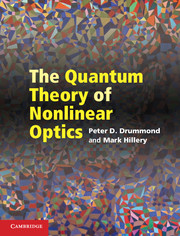Book contents
- Frontmatter
- Contents
- Preface
- Introduction
- 1 Classical nonlinear optics
- 2 Field quantization
- 3 Quantized fields in dielectric media
- 4 Microscopic description of media
- 5 Coherence and quantum dynamics in simple systems
- 6 Decoherence and reservoirs
- 7 Phase-space distributions
- 8 Single-mode devices
- 9 Degenerate parametric oscillator
- 10 Quantum field dynamics
- 11 Quantum propagation in fibers and waveguides
- 12 Quantum information
- List of symbols
- Index
- References
3 - Quantized fields in dielectric media
Published online by Cambridge University Press: 05 May 2014
- Frontmatter
- Contents
- Preface
- Introduction
- 1 Classical nonlinear optics
- 2 Field quantization
- 3 Quantized fields in dielectric media
- 4 Microscopic description of media
- 5 Coherence and quantum dynamics in simple systems
- 6 Decoherence and reservoirs
- 7 Phase-space distributions
- 8 Single-mode devices
- 9 Degenerate parametric oscillator
- 10 Quantum field dynamics
- 11 Quantum propagation in fibers and waveguides
- 12 Quantum information
- List of symbols
- Index
- References
Summary
We have seen how to quantize the electromagnetic field in free space, so let us now look at how to quantize it in the presence of a medium. We will first consider a linear medium without dispersion, and then move on to a nonlinear medium without dispersion. Incorporating dispersion is not straightforward, because it is nonlocal in time; the value of the field at a given time depends on its values at previous times. This is due to the finite response time of the medium. We will, nonetheless, present a theory that does include the effects of linear dispersion.
It is worth noting that the quantization of a form of nonlinear electrodynamics was first explored in a model of elementary particles by Born and Infeld. Their theory was meant to be a fundamental one, not like the ones we are exploring, which are effective theories for electromagnetic fields in media. However, many of the issues explored in the Born–Infeld theory reappear in nonlinear quantum optics.
The approach adopted in this chapter is to quantize the macroscopic theory, that is, the theory that has the macroscopic Maxwell equations as its equations of motion. A different approach, which will be explored in a subsequent chapter, begins with the electromagnetic field coupled to matter, i.e. the matter degrees of freedom are explicitly included in the theory. One is then able to derive an effective theory whose basic objects are mixed matter–field modes called polaritons.
- Type
- Chapter
- Information
- The Quantum Theory of Nonlinear Optics , pp. 83 - 115Publisher: Cambridge University PressPrint publication year: 2014



